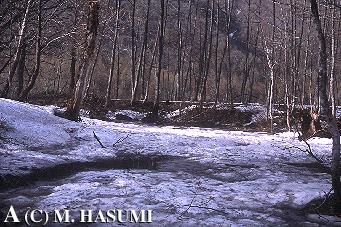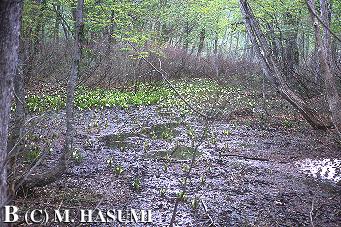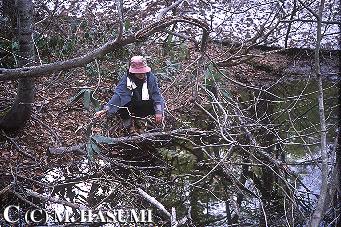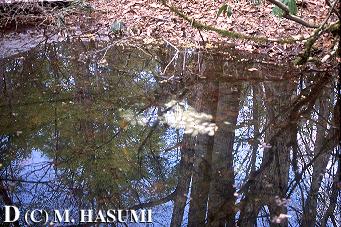



 |  |
 |  |
(A) Gross appearance of the wetland (photographed on 30 April 2005). At this time, snow of 20-30 cm still covered all the wetland but a few regions where water was penetrated. In these regions, some Lysichiton camtschatcense were beginning to bloom, and no egg sac of H. nigrescens was found.
(B) A change in gross appearance of the wetland after a couple of weeks (photographed on 14 May 2005). A total of 100 pairs of egg sacs of H. nigrescens were deposited in the inundated regions. Among them, about 10 pairs of egg sacs were a translucent type (others were an opaque-white type). A back of the wetland, in which the end of the surface stream was recognized, had 14-15 pairs of egg sacs of this species. At the time of examination, so many iron bacteria, looked like a machine oil, were floating on the surface of the water.
(C) A temporary pool with a water depth of 30 cm (water temperature = 11.7 C, water pH = 6.3), caused by thawing (photographed on 14 May 2005). A lady sitting down at the side of the pool was Y. Saikawa. Note much remaining snow (upper range).
(D) Approximately 100 pairs of egg sacs of H. nigrescens, concentrated to a site in the pool (photographed on 14 May 2005). Many of these egg sacs involved embryos of the blastopore stage. Judging from egg sac absorption, several pairs of egg sacs 2 days after deposition seemed to be newest. No adult of this species was found in anywhere. These results suggest this population exhibited an explosive reproductive pattern within 2 weeks.
Surprisingly, a subadult of the lotic-breeding salamander Hynobius kimurae was discovered among decaying leaves on a slope just at an opposite side of the wetland across a road. There were several branched streams near this site. The subadult possessed 4 toes in both hindlimbs (body mass = 3.6 g, total length = 87.56 mm, snout-anterior vent length = 51.96 mm, snout-posterior vent length = 55.33 mm, broadest head width = 9.48 mm, maximum tail height = 6.26 mm).
Accompanied Research Collaborators (alphabetical order): Masaichi Kakegawa (Tokyo Metropolitan Komatsugawa Senior High School), and Fujio Kishi and Yuko Saikawa (Shirouma Association of Naturalists).